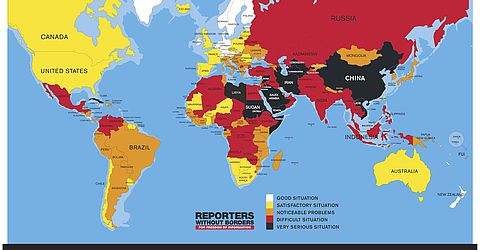Cambodia
The Media Ownership Monitor Cambodia revealed high levels of ownership concentration, a low transparency level, and a problematic dependency of media outlets on the government. The research and publication, jointly conducted together with the Cambodian Center for Independent Media (CCIM) from September to December 2015 and relaunched in 2018, highlights the related dangers to media freedom, particularly thorugh self-censorship and the absence of critical reporting.
- High media concentration, especially for popular TV. The TV sector is the most popular and at the same time the most concentrated and most politically affiliated media sector: the top 4 media companies gather 78% of the viewership. Moreover, 7 of 10 relevant TV channels belong to owners affiliated to the ruling party - either being listed on the government payroll or appointed as advisors. The Cambodian Broadcasting Service (CBS) Corporation, that alone gathers 47% in the TV sector, is by far the most important media group in Cambodia. Owned by The Royal Group, CBS counts at least three media-related sister companies ranging from phone operations to digital TV and Internet Service Providers. This makes its owner, Kith Meng, one of the most influential media owners with the potentially highest leverage on public opinion in Cambodia. While the print sector is also highly concentrated with the top 4 outlets reaching 59% of the audience, it is important to keep in mind that only one out of 10 Cambodians reads newspapers or magazines. The radio market appears most fragmented, with 8 of the 10 most relevant radio stations, reaching between 3-6% of the audience, showing a medium concentration. The top media corporations and owners (Royal Group, Hang Meas, Hun Mana & Seng Bunveng) together reach 83.4% of the audience across all media sectors. This proofs an exceptionally high concentration of media companies that have a potential influence on public opinion.
- Media regulation in its infancy. The high degree of concentration illustrates the lack of an appropriate legal framework. Instead of having an independent body to regulate media concentration and ownership in the country, the in transparent licensing regime depends completely on the Ministry of Information. It appears in a critical role being the sole authority to officially allocate and revoke licenses in an opaque process, instead of establishing and entrusting an independent media authority.
- Media Ownership Transparency is low. The lack of corporate financial data related to the media sector made it impossible to evaluate the economic impact and dimension of concentration. While there was little public information on ownership structures available, proactively contacted media outlets proved very reluctant to respond: only one third provided complete data upon request.
According to the annual World Press Freedom Index produced by Reporters without Borders, Cambodia ranks 132th out of 180 countries in 2017.
Indicators of Risk to Media Pluralism






